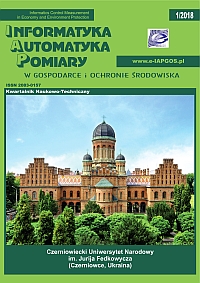INVARIANT PIEZORESONANCE DEVICES BASED ON ADAPTIVE MULTIFREQUENCY SYSTEMS WITH A PREDICTIVE STANDARD
Article Sidebar
Open full text
Issue Vol. 8 No. 1 (2018)
-
DETERMINATION OF THE EFFICIENCY FACTORS OF THE ABSORPTION AND SCATTERING OF NICKEL NANOPARTICLES
Oleksandr Machulianskyi, Bohdan Babych, Viktor Machulianskyi4-7
-
CONTROL MODEL OF DATA STREAM TRANSMITTED OVER A NETWORK BASED ON PROXYING TECHNOLOGY
Olesia Barkovska, Vitaliy Serdechnyi8-11
-
INVESTIGATION OF THE MEMRISTOR NONLINEAR PROPERTIES
Sviatoslav Khrapko, Volodymyr Rusyn, Leonid Politansky12-15
-
IMITATION MODELING OF THE ROUTING PROCESS BASED ON FUZZY LOGIC
Ivan Lesovoy, Genagij Pylypenko16-19
-
INVARIANT PIEZORESONANCE DEVICES BASED ON ADAPTIVE MULTIFREQUENCY SYSTEMS WITH A PREDICTIVE STANDARD
Sergey Pidchenko, Alla Taranchuk20-23
-
DEVELOPMENT AND RESEARCH OF CRYPTOGRAPHIC HASH FUNCTIONS BASED ON TWO-DIMENSIONAL CELLULAR AUTOMATA
Yuliya Tanasyuk, Sergey Ostapov24-27
-
GENERALIZED APPROACH TO HURST EXPONENT ESTIMATING BY TIME SERIES
Lyudmyla Kirichenko, Tamara Radivilova, Vitalii Bulakh28-31
-
SPECTRAL SENSITIVITY OF HUMAN VISION TO THE LIGHT PULSES
Volodymyr Brailovsky, Ivan Pyslar, Magharyta Rozhdestvenska, Magdalena Michalska32-35
-
ORGANIZATION OF IMPLEMENTATION OF UBIQUITOUS SENSOR NETWORKS
Sergey Toliupa, Yuriy Kravchenko, Aleksander Trush36-39
-
PECULIARITIES OF THE RADIO SIGNALS AND HINDRANCES IN THE NAVIGATION SYSTEM OF THE REMOTE-PILOTED VEHICLES
Mykola Mykyjchuk, Volodymyr Markiv40-43
-
DISTORTIONLESS SIGNALS TRANSFER THROUGH A WIRE MEDIA METASTRUCTURE
Dmytro Vovchuk, Serhii Haliuk, Leonid Politanskyy44-47
-
THE USE OF ARTIFICIAL INTELLIGENCE IN AUTOMATED IN-HOUSE LOGISTICS CENTRES
Tomasz Rymarczyk, Grzegorz Kłosowski48-51
-
USING MICROSERVICES ARCHITECTURE AS ANALYTICAL SYSTEM FOR ELECTRICAL IMPEDANCE TOMOGRAPHY IMAGING
Tomasz Cieplak, Tomasz Rymarczyk, Grzegorz Kłosowski52-55
-
OPTIMIZATION OF DATA PROCESSING FOR REQUESTING OBSERVATION SYSTEMS
Iryna V. Svyd, Andrij I. Obod, Oleksandr S. Maltsev, Daria B. Pavlova, Bridel V. Mongo56-59
-
METHODS OF PRODUCING APODIZED FIBER BRAGG GRATINGS AND EXAMPLES OF THEIR APPLICATIONS
Łukasz Zychowicz, Jacek Klimek, Piotr Kisała60-63
-
DEAD TIME MEASUREMENT BY TWO-SOURCE METHOD – OPTIMIZATION OF MEASUREMENT TIME DIVISION
Grzegorz Domański, Bogumił Konarzewski, Robert Kurjata, Krzysztof Zaremba, Janusz Marzec, Michał Dziewiecki, Marcin Ziembicki, Andrzej Rychter, Waldemar Smolik, Roman Szabatin, Piotr Brzeski64-66
-
ANALYSIS OF THE BENDING STRAIN INFLUENCE ON THE CURRENT- -VOLTAGE CHARACTERISTICS OF HTC SUPERCONDUCTING TAPES
Jacek Sosnowski67-70
-
DETERMINATION OF R = F(T) CHARACTERISTICS OF THE FIRST AND SECOND GENERATION SUPERCONDUCTING TAPES
Rafał Kwoka, Janusz Kozak, Michał Majka71-74
Archives
-
Vol. 10 No. 4
2020-12-20 16
-
Vol. 10 No. 3
2020-09-30 22
-
Vol. 10 No. 2
2020-06-30 16
-
Vol. 10 No. 1
2020-03-30 19
-
Vol. 9 No. 4
2019-12-16 20
-
Vol. 9 No. 3
2019-09-26 20
-
Vol. 9 No. 2
2019-06-21 16
-
Vol. 9 No. 1
2019-03-03 13
-
Vol. 8 No. 4
2018-12-16 16
-
Vol. 8 No. 3
2018-09-25 16
-
Vol. 8 No. 2
2018-05-30 18
-
Vol. 8 No. 1
2018-02-28 18
-
Vol. 7 No. 4
2017-12-21 23
-
Vol. 7 No. 3
2017-09-30 24
-
Vol. 7 No. 2
2017-06-30 27
-
Vol. 7 No. 1
2017-03-03 33
-
Vol. 6 No. 4
2016-12-22 16
-
Vol. 6 No. 3
2016-08-08 18
-
Vol. 6 No. 2
2016-05-10 16
-
Vol. 6 No. 1
2016-02-04 16
Main Article Content
DOI
Authors
Abstract
The paper presents conceptual provisions for the construction of invariant multi-frequency piezoelectric resonance devices with a predictive reference model. The law of the optimal control of the system in real time is formulated, aimed at minimizing energy costs to ensure the trajectory of the system. The results of piezoelectric resonance system mathematical modelling in the conditions of temperature and vibration perturbations are presented.
Keywords:
References
Lam C.: A review of the recent development of MEMS and crystal oscillators and their impacts on the frequency control products industry. IEEE Ultrasonics Symposium 2-5 Nov 2008, Beijing, China, 694–704.
Pidchenko S., Taranchuk A.: Principles of Quartz Multifrequency Oscillatory Systems with Digital Compensation of Temperature and Vibrational Instability Frequency. Int. Conf. Radio Electronics & Info Communications (UkrMiCo): 11-16 Sept. 2016, Kiev, Ukraine, 281–284.
Pidchenko S.: Dual-frequency temperature-compensated quartz crystal oscillator CriMiCo. 23rd Int. Crimean Conf. Microwave and Telecommunication Technology 8-14 September 2013, Sevastopol, Ukraine, 669–670.
Pidchenko S.: Theory and fundamentals implementation of invariant piezoresonance devices and systems. KNU, Khmelnytskyi 2014.
Taranchuk A., Pidchenko S., Khoptinskiy R.: Dynamics of temperature-frequency processes in multifrequency crystal oscillators with digital compensations of resonator performance instability. Radioelectronics and Communications Systems 58(6)/2015, 250–257.
Article Details
Abstract views: 327
License

This work is licensed under a Creative Commons Attribution-ShareAlike 4.0 International License.






